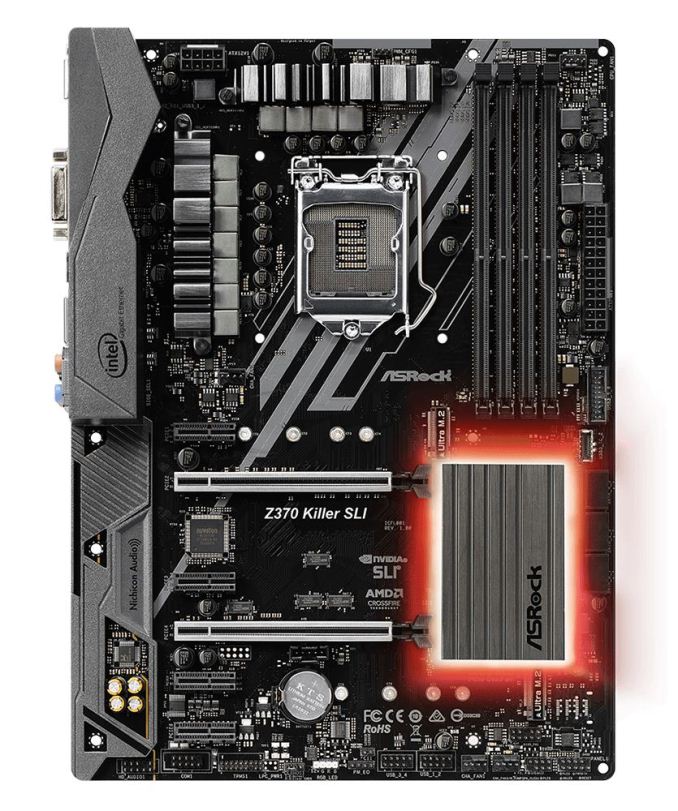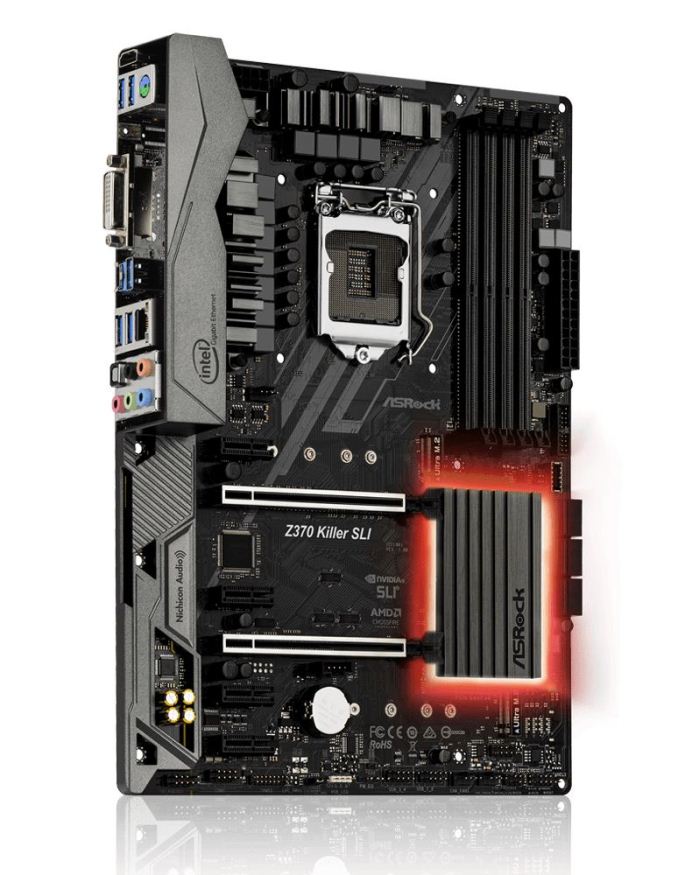Analyzing Z370 for Intel's 8th Generation Coffee Lake: A Quick Look at 50+ Motherboards
by Ian Cutress, Anton Shilov, Joe Shields & Gavin Bonshor on October 20, 2017 2:00 PM ESTASRock Z370 Killer SLI and Killer SLI AC
The ASRock Z370 Extreme line consists of the Z370 Killer SLI/ac, Killer SLI, and the Extreme4. Both of the Killer SLI boards will be covered on this page as the only difference between the two is the wireless LAN which comes with the SLI/ac. Some of the differences between the Gaming line and the Extreme line are the power delivery, different controllers/caps/chokes, different heatsinks, and controller choice allowing for cost-saving efforts to keep the price to the consumer lower than the Gaming or Professional branded motherboards.
Both the Killer SLI and SLI/ac look exactly the same outside of the back panel IO where the ac model has the Intel Wi-Fi card out back. The shared board otherwise is an all-black affair, outside of some artwork on the PCB going through the socket area. The chipset heatsink is more of a simple rectangle on the Killer boards compared to the Gaming boards, and has RGB LEDs below it. An RGB header is located on the bottom of the boards for adding another LED strip. Shrouding covers the back panel and audio sections, while the last design aesthetic that sticks out is the two full-length reinforced PCIe slots.
The four memory slots support the platform maximum of 64 GB, with supported speeds up to DDR4-4266. That value is still faster than most boards covered in the roundup, but one notch below the high-end ASRock boards. There are two full-length reinforced slots fed from the CPU, capable of x16 and x8/x8 connectivity, and four x1 slots from the chipset. Both 2-way SLI and 3-way Crossfire are supported (as well as quad SLI/Crossfire with dual GPUs).
The Killer SLI and SLI/ac both include six SATA ports supporting RAID 0, 1, 5, and 10. Additional storage is handled by two M.2 slots; the first is located above the top full-length PCIe slot and supports drives up to 80mm, while the second is located towards the bottom of the board below the chipset heatsink and supports drives up to 110mm. Be aware of slot sharing; if the first M.2 slot is occupied by a SATA device, SATA5 will be disabled, while if the second M.2 slot is occupied by a SATA module, SATA0 will be disabled.
Fan control is handled through the BIOS or via the F-Stream software, and gives control to all the fan headers: a CPU fan header (1A/12W), two chassis Fan headers, and a chassis optional/water pump header (1.5A/18W). Audio duties are handled by the last generation ALC892 codec, but is upgraded with the use of Nichicon Gold series audio caps. Network connectivity is handled by a single Intel I219-V on both boards with the SLI/ac adding the Intel Wi-Fi module for wireless support. The online specifications do not state which Wi-Fi module this is, although it is likely to be the AC3165.
USB connectivity is the same on both boards with neither utilizing the USB 3.1 (10 Gbps) controllers. On the back panel there are five USB 3.1 (5 Gbps) ports and one Type-C port. Additionally, there are two internal USB 2.0 headers supporting four ports, and another internal USB 3.1 (5 Gbps) header yielding two more ports. All USB ports are handled by the chipset. The back panel IO also has two video outputs with an HDMI and DVI-D port, as well as a 5 plug audio stack plus SPDIF. The Killer SLI/ac is the one with the Intel Wi-Fi antenna ports out back as well.















83 Comments
View All Comments
Aichon - Friday, October 20, 2017 - link
Love this writeup. Thank you guys so much for putting it together so that we can make sense of the choices.peevee - Friday, October 20, 2017 - link
"These motherboards range from $110 "AM4 MBs start from $40 on newegg. Yet another way AMD provides better value.
DigitalFreak - Friday, October 20, 2017 - link
You want a cookie or something?cap87 - Saturday, October 21, 2017 - link
Nobody cares, this a Z370 article. Go back to your cave with the rest of you AMD buddies.imaheadcase - Saturday, October 21, 2017 - link
Apples to oranges.IGTrading - Sunday, October 22, 2017 - link
Very good comment. Not everybody is going to buy a 8700K and thr cheaper CPUs don't really make sense in a 150 USD motherboard.Also, because Intel doesn't guarantee the Boos frequencies anymore, you don't really know what you're going to get with a 8400 for example.
This was very well exemplified here: https://youtu.be/O98qP-FsIWo
psychocipher - Sunday, October 22, 2017 - link
Theres a difference between value and quality. better quality with more features tend to cost more. Dont hate cause amd doesnt get motherboards like the apex. If zen+ increases clock speeds and increases overclocks to where intel is yall will be wishing you didnt buy a cheap $40 b350 motherboard. Yeah you get to keep your cheap b350 motherboard for zen+ but yeah lets buy a new cpu cause amd is providing better value.OFelix - Friday, October 20, 2017 - link
I haven't read the article yet but I want to say that to make sense of 50+ MBs I'm going to need a comparison system which let's me find all MBs with ThunderBolt for example.Brett Howse - Friday, October 20, 2017 - link
Check the last page.Ian Cutress - Friday, October 20, 2017 - link
+1